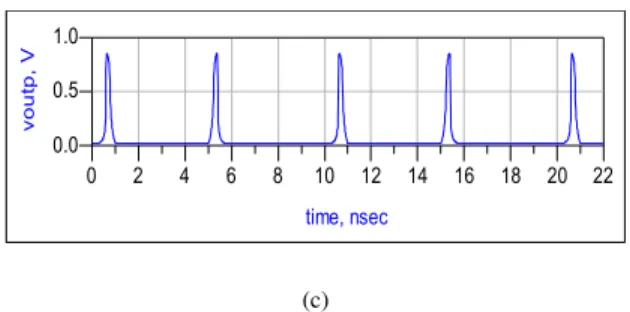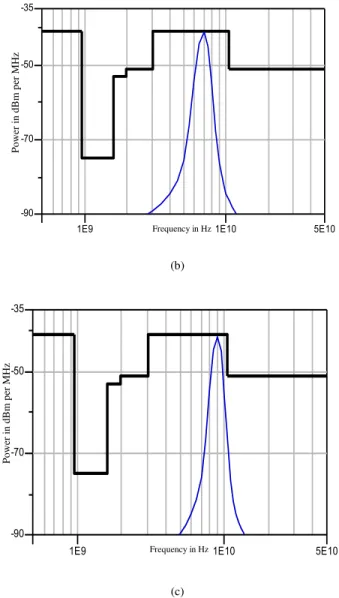3.51pJ/pulse/1.2V CMOS IR-UWB Transmitter
Sagar K. Dhar1, Shuvashis Chakraborty2 and Pranab Biswas1
1
Department of Electrical and Electronic Engineering, Premier University Chittagong, 4203, Bangladesh
2
Department of Energy Auditing, Power Development Board (PDB) Sylhet, 3100Bangladesh
Abstract
Spectrum tuning and meeting low power are the main challenges in impulse radio ultra-wideband (IR-UWB) system while it has the highest level of prospects in contactless and continuous vital sign monitoring. In this paper, an IR-UWB transmitter is designed for the most desirable feature of IR-UWB that is exact spectral tuning along with the lowest energy consumption ever reported which is solved using underdamped operation of an RLC circuit incorporated with three step amplitude tuning. Highly selective underdamped circuit is used to reduce the sideband spectral component that reduces signal power and hence energy consumption. Exact damping of oscillation is implemented using negative impedance effect of a source follower with positive feedback. Results of the presented design are carried out in Advanced Design System 2009. Exact spectrum generation with center frequency 5, 7 and 9GHz of 2GHz bandwidth is tested. The maximum power transmission is set below -41dBm per MHz and the energy consumption is only 3.51pJ per pulse per 1.2V supply.
Keywords: Impulse Radio, UWB, Gaussian Pulse, Bio-sensing, Transmitter.
1. Introduction
Electromagnetic bio-sensors are showing the highest level of prospects in contactless and continuous vital sign monitoring. Such bio-sensing systems generally have two parts: a sensor of some kinds and a communication infrastructure such as transceiver and protocols to share data collected by the sensor. Among different possible sensing and imaging technologies, UWB detection and imaging is preferable for non-invasive and contactless biomedical sensing due to its resolution. It can be used for a perfect radar that is possible to deploy for short range detection (that offers contactless bio-sensing) and because it has resistance to multipath (a consequence of its resolution), it is possible to use for communication with high speed; and both tasks can be performed using the same design (i.e. same pulse shape, same frequency, transmitted power) [1]. It is also beyond questioning the impact of UWB radiation on health because UWB radar sensing is possible with even approximately 1µW [2] which is about three orders of magnitude lower than most
international standards for continuous human exposure to microwaves. These issues make UWB as an appropriate selection for bio-sensing. And to meet the low power requirements, carrier less IR-UWB system is preferable. Moreover, IR-UWB is an inherently duty cycled system which allows to turn off the output of the transmitter during the intervals between two impulses which reduces average power consumption. In essence, IR-UWB transceiver systems are getting popularity in the field of contactless and continuous vital sign monitoring day by day because of their suitability as a wearable and wireless technology. However, the main problem yet with IR-UWB is the exact controlling of output spectrum while meeting the FCC mask and still offering low power consumption for continuous monitoring.
derivative 4.7pJ/pulse Gaussian pulse generator implemented by a 5th derivative digital circuit similar to [9,10] along with a 2nd derivative RLC circuit which although reduce low frequency spectral component but still have high side lobe spectrum beyond 10.6 GHz even fails to meet FCC mask beyond 10.6 GHz.
In this paper, an ultra-low power CMOS IR-UWB transmitter is presented with exact spectrum tuning tested for 3 bands centered at 5, 7 and 9GHz under the FCC restrictions having maximum average power of -41dBm per MHz and energy consumption of 3.51pJ per pulse per 1.2V supply which is the lowest ever reported by previous works. The proposed design eliminates the complexity of integrating exact R values using active circuit alternatives. The key point in meeting low power requirement of Gaussian pulse generation yet applying mixed signal technique is the highly selective underdamped circuit. This technique actually reduces the sideband power in the Gaussian pulse compared to the digital circuit implementation which is actually based on the principle of differentiating a Gaussian pulse realized by stacking delayed version of digital pulses.
2. Methods and Principles
IR-UWB transmitters are of great interest in bio-sensing applications and a very simplified form of IR-UWB system for heart rate monitoring is in general a transmitter incorporated with a receiver section. In the transmitter, the fundamental issue is a Gaussian pulse generator under FCC power restriction [15] shown in Table 1 where the main concern is yet to generate exact transmitting spectrum and to meet ultra-low power consumption. The mathematical expression for Gaussian pulse and its first and second order derivatives are shown in Eq. (1-3). But the spectra of these pulses shown in Fig. 1 do not meet the FCC restriction. However, it is evident from Fig. 1 that if the pulse is differentiated to higher orders, the centre frequency of the pulse in frequency domain is shifted without changing its total bandwidth and usually 7th order derivative is required for meeting spectral restrictions.
2
2
( ) exp( )
2 2
A t
x t
(1)
2
2 3
( ) exp( )
2 2
At t
x t
(2)
2
2 2
5 3
( ) ( exp( )
2 2
) 2
At t
x t A
(3)
TABLE1:FCC power restrictions for indoor applications
Frequency (GHz)
Max. Power in dBm/MHz
Frequency (GHz)
Max. Power in dBm/MHz
0.5-0.96 -41.3 1.99-3.1 -51.3
0.96-1.61 -75.3 3.1-10.6 -41.3
1.61-1.99 -53.3 10.6-50.6 -51.3
0 0.5 1 1.5 2 2.5 3 3.5 4 4.5 5
x 10-3 -250
-200 -150 -100 -50 0 50 100
Normalized Frequency ( rad/sample)
M
a
g
n
it
u
d
e
(
d
B
)
Frequency domain
0 order 1st order 3nd order 5rd order 7th order
Fig. 1 Spectrum of different order Gaussian pulse
On the other hand, if the duration of the pulse in time domain is increased by increasing σ in (1) as shown in Fig. 2 (sd1<sd2<sd3), the bandwidth is decreased and vice versa. These phenomena are used in previous works [6-11] for developing FCC compliant Gaussian pulse where actually delayed version of digital pulses are stacked one after another to form equivalent higher order derivative signal. But implementation of higher order derivative of Gaussian pulse in this manner has higher sideband spectral components as shown in Fig. 3andalternatively mitigates the vantage of digital implementation regarding power. One possible solution to this problem is to modulate the Gaussian pulse with a carrier signal instead of derivatives to have a precise spectrum.
0 1 2 3 x 10-4 -200
-150 -100 -50 0 50 100
Normalized Frequency ( rad/sample)
M
a
g
n
itu
d
e
(
d
B
)
Frequency domain
sd1 sd2 sd3
(b)
Fig. 2 Pulse width vs. Bandwidth: (a) time and (b) frequency domain.
But modulating with a carrier signal will drastically increase the power consumption in the transmitter unit. The solution suggested in this paper is to use a highly selective underdamped circuit creates less side band spectral components compared to higher order derivatives made by delayed version of digital signals as shown in Fig. 3. Moreover, in this technique, the bandwidth and the centre frequency is possible to select precisely by controlling the duration and oscillation of damping respectively.
0 0.01 0.02 0.03 0.04 0.05 0.06 0.07 0.08 0.09 -250
-200 -150 -100 -50 0 50
Normalized Frequency ( rad/sample)
M
a
g
n
itu
d
e
(
d
B
)
Frequency domain
Underdamped signal spectrum digitally implemented signal spectrum
Fig. 3 Spectrum of digitally implemented and proposed Gaussian pulse
In this paper, at first the Gaussian like pulse is generated combining the edges of digital signals as shown in Fig. 4 which then excites an under-damped RLC circuit for generating modulated Gaussian pulse. The duration of the pulse could be precisely controlled by R value. On the other hand, oscillation frequency is controlled by varying C value and the inductance is for high selectivity. However, precision of R is difficult to attain in integrated circuits and alternatively the controlling of spectrum is implemented with active circuits using negative resistance concept. And negative resistance is implemented by the phenomenon that it is an incremental quantity i.e. an increment in voltage would cause a decrement in current just inverse concept of a resistive effect. This concept is implemented by a source follower with positive feedback further discussed in 3.3.
0.5
0.0 1.0
Vi
n,
V
0.5
0.0 1.0
Vi
nv
, V
0.5 1.0 1.5 2.0 2.5 3.0 3.5 4.0 4.5
0.0 5.0
0.2 0.4 0.6 0.8
0.0 1.0
time, nsec
vo
ut
p,
V
Fig. 4 Gaussian Pulse Generation
Fig. 5 Controlling pulse shape and the bandwidth varying R and C
Again, an FCC compliant IR-UWB transmitter could be useful in sensing physiological information such as heart rate and respiration. And based on this bio-information, survivor detection in disasters and surveillance system are possible to develop. The heart of an adult person if considered as 12cm in length, 8 to 9cm in breadth and 6cm in thickness [12], it can be approximated as a sphere of radius 6cm. [13] presents the feasibility of heart rate monitoring 15cm apart under FCC power restrictions considering total attenuation of 30dB from body surface to heart and heart to body surface again although this range 15cm could be increased to about 1m for gated pulse [11] as presented in this paper still meeting the FCC restrictions.
3. Transmitter Architecture
The block diagram of the transmitter proposed in this work is shown in Fig. 6 comprised of 4 major parts: a) Gaussian pulse generator, b) amplitude tuning, c) frequency tuning and d) output buffer.
Fig. 6 Block diagram of transmitter Spectrum
Tuning
Output Buffer Gaussian
Pulse Generator
3.1 Gaussian Pulse Generation
Two categories of pulse generator exist: analog pulse generators and digital pulse generators. [4] presents analog pulse generator that employs square and exponential functions of transistors biased in saturation and weak inversion region respectively. The main disadvantage of such pulse generators is the extremely low pulse amplitude. On the other hand, digital pulse generators combine the edge of a digital signal with its inverted version that eliminates the problem of low amplitude of analog pulse generators. In this paper, the Gaussian pulse is generated with XNOR operation of a digital signal and its inversion as shown in Fig. 7.
3.2 Amplitude Scaling
Amplitude tuning is optimised for meeting the FCC mask and designed in this paper with common source amplifier with current source load as shown in Fig. 8. Attenuation for different transmission frequency band is different which demands amplitude tuning to maintain FCC restrictions. In this paper, the gain and hence the amplitude is controlled with the trans-conductance (i.e. aspect ratio) of MOSFET1-MOSFET6. Three step amplitude control is obtained by applying 1 or 0 to the vctrl1-vctrl3 for three band of testing spectrum centred at 5, 7 and 9GHz.
(a)
(b)
2 4 6 8 10 12 14 16 18 20
0 22
0.5
0.0 1.0
time, nsec
v
o
u
tp
,
V
(c)
Fig. 7 Pulse generator: (a) logic circuit, (b) CMOS circuit, (c) pulse waveform.
3.3 Spectrum Tuning
Frequency tuning of transmitted pulse can be obtained by digital or analog circuits. [9-10] present IR-UWB system using digital circuits where 4 pulses are combined successively to form fifth derivative of Gaussian pulse which alternatively offers modulated Gaussian pulse without a carrier signal. Moreover, this method eliminates inductor for analog implementation and reduces the chip area in a great manner. But unfortunately, this method severely suffers from process variation and the signal implemented by stacking digital pulses has higher sideband spectral components which increase signal power. In this paper, an underdamped RLC network is used for up-conversion and spectrum control is realised using negative impedance effect of a source follower with positive feedback.
Negative resistance effect is implemented with the fact that it is an incremental quantity, that is, if the applied voltage increases, the current drawn by circuit decreases [14]. In Fig. 9, a source follower with positive feedback is shown for negative impedance realisation where if the input voltage increases, so does the source voltage of MOSFET2, decreasing the drain current of MOSFET1 which makes the effect of negative resistance values as –(1/gm1+1/gm2)
as shown in Fig. 9. This active circuit implementation of negative resistance would eliminate complexities in exact R value integration as in many recent and past analog approaches of Gaussian pulse implementation.
In Fig. 10(b), L1, gate parasitic capacitance of MOSFET4
and MOSFET5, depletion mode MOSFET9 combined with negative resistance and C4/C5/C6 activated with
FCTRL1-FCTRL3 introduces the underdamped oscillation characterised by exponentially decaying sinusoids already shown in Fig. 5. The circuit is analogous to a parallel RLC circuit shown in Fig. 5 fed by a current source which is the amplitude tuning circuit in this case has the general solution for the transfer function variable
21 1 1
2 2
s
RC RC LC
. For underdamped operation,
1/LC is set to be higher than (1/2RC) 2. So, the duration is possible to control with resistive effect for a definite bandwidth and then centre frequency of pulse is controlled with capacitive effect using Fctrl1-Fctrl3 in the 3.1-10.6 GHz range while remaining RC value fixed.
Fig. 9 Active circuit for negative resistance realisation
3.4 Buffer Circuit
Since, the transmitted power of IR-UWB is very low, power amplifier is not essential. In this paper, an output buffer is designed for generally two purposes: a) driving the antenna and b) gated transmission. A cascode arrangement is applied for antenna driving and input-output isolation. On the other hand, the gated transmission is implemented with a PMOS switch (MOSFET8) in Fig. 10(b) which provides no static current consumption where the RST signal generation is shown in Fig. 10(a). Capacitor C3 is used to cancel out the noise generated from
switching on/off. Use of output buffer would decrease average power of transmitted signal.
RST
Rect.
Pulse
(a)
(b)
Fig. 10 (a) RST signal logic circuit, (b) frequency tuning and output buffer circuit
4. Results and Discussions
The IR-UWB transmitter is designed and simulated in Advanced Design System 2009. Exact spectrum generation for IR-UWB system is tested at 5, 7 and 9GHz centre frequency meeting the FCC regulations with no static current and only 3.51pJ/pulse/1.2V energy consumption. A final Gaussian pulse shape of the transmitter unit at the output of buffer circuit is shown in Fig. 11.
0.5 1.0
0.0 1.5
v
o
u
t1
,
V
0.5 1.0 1.5 2.0 2.5 3.0 3.5 4.0 4.5
0.0 5.0
-100 0 100
-200 200
time, nsec
v
o
u
tf
,
m
V
Fig. 11 Gaussian pulse after frequency tuning and buffer circuit
TABLE2:Comparison of parameters of proposed transmitter with previous works
Refs. f-Band (GHz)
Duration (ns)
Vpp (mV)
Power (pJ/pulse)
This work 3-10 2.75 137 3.51
[6] 5.1-5.6 1.7 250 313
[7] 3-10 17 200 40
[8] 0.5-5 0.8 330 63
[9] 3.1-10.6 0.77 66 5.1
[10] 3.1-10.6 2.4 148 58
[11] 3.1-5.1 0.8 500 4.7
Among the previous works, [11] presents the lowest powered FCC compliant Gaussian pulse where 5th derivative Gaussian pulse like signal is first derived from digital circuits and further 2nd order RLC derivative circuit is used for pulse shaping. But the PSD of the Gaussian pulse signal of this work shows very large sideband spectral component even sometimes fails to meet FCC restrictions beyond 10.6GHz and reducing side lobe spectral components can reduce energy consumption further according to the concept that the total energy of a
signal is: 2 2
( ) ( )
x t dt X f df
E
i.e. if we canconcentrate the spectral components of the transmitting signal in the working band rather than distributed in the lower and higher sidebands, we could be able to arrange lower powered transmitting signal without losing the signal strength in the operating band.
1E10
1E9 5E10
-70 -50
-90 -35
(a)
On the other hand, [9] presents a 5.1pJ/pulse all digital Gaussian pulse transmitter unit. But still the problem is with remaining high side lobe spectral components. In the work [9], because of the distribution of signal energy in the side lobe spectral components, the maximum signal PSD is about -55dBm/MHz only which is much lower than the maximum allowable PSD of -41dBM/MHz by the FCC restrictions. That is to meet the low power requirement of the transmitted signal, the signal to noise ratio (SNR) is compromised in [9] which is not desirable when the IR-UWB transmitter is likely to be used for contactless bio-sensing where the SNR increases the distance of bio-sensing directly.
1E10
1E9 5E10
-70 -50
-90 -35
(b)
1E10
1E9 5E10
-70 -50
-90 -35
(c)
Fig. 12 Power spectrum density with FCC mask for center frequency: (a) 5GHz, (b) 7GHz and (c) 9GHz.
Alternatively, in this work the low and high side lobe components are carefully treated to reduce where the low frequency side lobe spectral components are cancelled out
Frequency in Hz
Frequency in Hz Frequency in Hz
P
owe
r
in
dB
m
pe
r
M
Hz
P
owe
r
in
dB
m
pe
r
M
Hz
P
owe
r
in
dB
m
pe
r
M
using C1 in Fig. 10(b) and high frequency side lobe components are carefully reduced using a high selectivity LC circuit comprised of L1 and triggering C1, C2 and C3 for three center frequency 5, 7 and 9GHz. The results in Fig. 12(a-c) show very low side lobe spectral components which indicate the concentration of the signal energy in the operating band and make possible the lowest energy consumption per pulse i.e. only 3.51pJ/1.2V.
5. Conclusion
In this work, an IR-UWB transmitter is designed and tested with the lowest energy consumption ever reported which is only 3.51pJ/pulse/1.2V and has the option of spectrum tuning in the range of 3.1 to 10.6GHz. Low energy transmitting signal is realised in this proposed transmitter by cancelling out the side lobe spectral components using careful operation of LC filters. Such transmitters would be efficiently applicable not only for bio-sensing such as heart and respiration rate monitoring but also for rescue operation in earth quake, surveillance system and in airport check in/out incorporated with a receiver.
Acknowledgment
The authors wish to acknowledge the invaluable suggestions, reviews and supports by Mr. Tanzilur Rahman, Research Assistant, Tokyo University.
References
[1] Hussain, M.G.M, “Ultra-wideband impulse radar- an overview of the principles,” IEEE Aerospace and Electronics Systems Magazine, Vol.13, No.9, pp.9-14, Sept, 1998.
[2] McEwan, T.; Azevedo, S.; “Micropower Impulse Radar”; Science & Technology Review; Lawrence Livermore National Labora-tory, US; Jan./Feb. 1996.
[3] X. Chen and S. Kiaei, “Monocycle shapes for ultra-wideband system”, IEEE Int, Symp. Circuits And Systems (ISCAS), bol.1, pp.597-600, May 2002.
[4] Y. Zheng, Y. Tong, C. W. Ang, et al., “A CMOS carrier less UWB transceiver for WPAN applications,” IEEE Int. Solid-State Cir. Conf., pp.116-117, 2006.
[5] J. Han and C. Nguyen, “A new ultra-wideband ultra-short monocycle pulse generator with reduced ringing”, IEEE Microwave and Wireless Components Letters, vol.12, no.6, pp.206-208, 2002.
[6] D. Wentzloff and A. Chandrakasan, “Gaussian pulse generators for subbanded ultra wideband transmitters”, IEEE transactions on UWB, Zurich, Switzerland, pp1647-1655, 2006.
[7] J. Ryckaert, G. Van der Plas and et al., “A 0.65 to 1.4nJ/burst 3-10GHz UWB all digital TX in 90nm CMOS for IEEE 802.15.4a”, IEEE JSSC, vol.42, no.12, pp2860 -2896, 2007.
[8] L. Smaini, C. Tinella and et al., “Single chip CMOS pulse generator for UWB systems”, IEEE JSSC, vol.41, no.7, pp.1551-1561, 2006.
[9] Q. Bo, C. Hongyi and et al., “An ultra-low power FCC compliant 5th Derivative Gaussian Pulse generator for IR-UWB Transceiver”, Chinese Journal of Electronics, vol. 18, no. 4, pp605-609, Oct. 2009.
[10] H. Kim, Y. Joo, “Fifth derivative Gaussian pulse generator for UWB system,” IEEE Radio Frequency Integrated Circuit Symp., pp.671-674, 2005.
[11] Tuan-Anh Phan, Hyun-seo Oh and Nae-Soo Kim, “ 4.7pJ/pulse 7th
derivative Gaussian Pulse Generator for Impulse Radio UWB”, IEEE Symp. on Circuits and Systems, pp. 3043-3046, 2007.
[12] Gray, Henry, Anatomy of Human Body, Philadelphia: Lea & Febiger, 1918, Bartleby.com, 2000.
[13] Carlos G. Bilich, “Feasibility of dual UWB heart rate sensing and communications under FCC power restrictions,” PhD Proposal, Dept. of Information and Telecom. Tech., University of Trento, Italy, 2006.
[14] B. Razavi, Design of Analog CMOS Integrated Circuit,
McGraw-Hill Higher Education, International Edition, 2001, pp.505-509.
[15] Freescale semiconductor, “UWB opportunities under the new FCC Waiver,” Doc. #UWBOPPFCCWVRWP rev.1, March, 2005.
Sagar K. Dhar BSc in Electrical and Electronic Engineering from
Chittagong University of Engineering and Technology in August, 2008; Lecturer, Department of EEE, Premier University; Member, IEEE, IEEE Circuits and Systems Society, IEEE Solid State Circuits Society and IEEE Communication Society; Ongoing research interests: Time based communication circuits, Data converters and Biosensors.
Shuvashis Chakraborty BSc in Electrical and Electronic
Engineering from Chittagong University of Engineering and Technology in August, 2008; Assistant Engineer, Energy Auditing,
Power Development Board, Bangladesh; Member, Engineer’s
Institute Bangladesh (IEB); Ongoing research interest: Electronic circuit design and Biosensors.
Pranab Biswas BSc in Electrical and Electronic Engineering from




